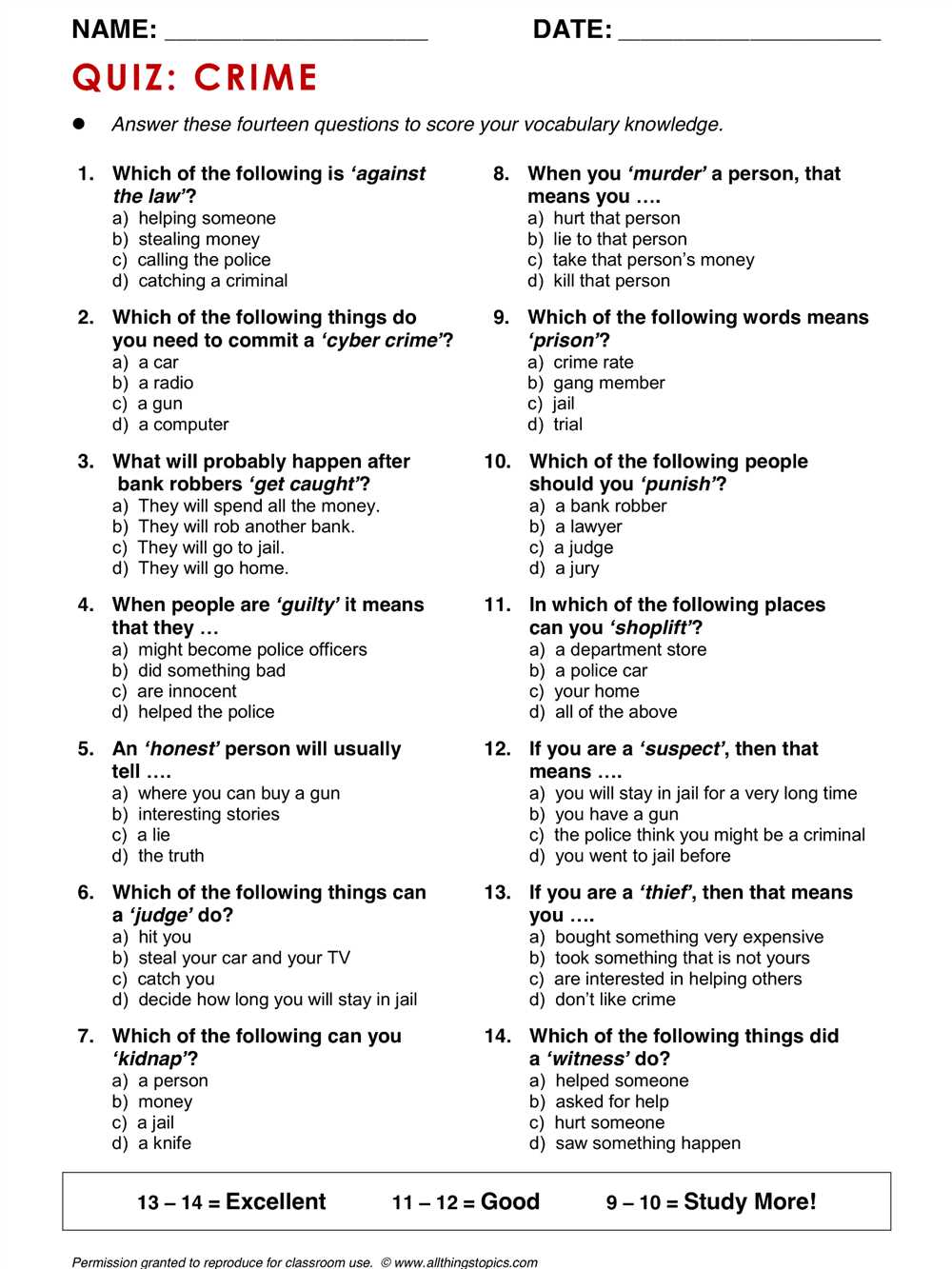
Welcome to our fascinating world of crime trivia! If you think you have what it takes to answer some challenging questions about notorious criminals, famous detectives, and gripping crime cases, then you’ve come to the right place. Test your knowledge and learn some intriguing facts along the way as we delve into the depths of the criminal underworld.
Whether you’re a true crime aficionado or just starting to dip your toes into the genre, these crime trivia questions will keep you engaged and entertained. From infamous serial killers to high-profile heists, we’ve compiled a diverse range of questions to suit every true crime lover’s interests.
Think you know the history of crime like the back of your hand? Put your detective skills to the test and see if you can correctly answer questions about notorious crimes throughout history, the methods of criminal investigation, and the stories behind some of the world’s most famous unsolved mysteries. Are you ready to prove that you’re the ultimate crime trivia master?
Crime Trivia Questions and Answers
Crime trivia questions and answers can be a fun way to test your knowledge of criminal activities and the justice system. Whether you’re hosting a trivia night or just looking to challenge yourself, these questions will keep you on the edge of your seat. So, grab a notepad and get ready to put your detective skills to the test!
1. Which notorious gangster was responsible for the St. Valentine’s Day Massacre in 1929?
- Al Capone
- John Dillinger
- Bonnie Parker
- Machine Gun Kelly
Answer: Al Capone
2. What was the name of the infamous serial killer who terrorized the streets of Victorian London?
- Jack the Ripper
- Ted Bundy
- Charles Manson
- Jeffrey Dahmer
Answer: Jack the Ripper
3. In what year was the United States prohibition era in effect, banning the production and sale of alcoholic beverages?
- 1919
- 1929
- 1939
- 1949
Answer: 1919
4. Which American city is notorious for its association with organized crime and the Italian-American Mafia?
- Chicago
- New York City
- Las Vegas
- Los Angeles
Answer: New York City
5. Who was the notorious dictator of Germany during World War II, responsible for numerous war crimes and the Holocaust?
- Adolf Hitler
- Benito Mussolini
- Hirohito
- Joseph Stalin
Answer: Adolf Hitler
These are just a few crime trivia questions to get you started. Now, challenge your friends and see who can answer the most correctly. Remember, knowledge is power when it comes to crime!
What is a crime?
A crime is an act or omission that violates a law and is punishable by the government. It is considered a wrongdoing against society as a whole, and the legal system seeks to maintain order and protect individuals by establishing and enforcing laws.
In general, crimes are categorized into various types, such as violent crimes, property crimes, financial crimes, and societal crimes. Violent crimes involve the use of force or the threat of force against another person, including offenses like murder, assault, and robbery. Property crimes involve the unlawful taking or damaging of someone else’s property, such as theft, burglary, and arson. Financial crimes involve illegal acts related to money, such as fraud, embezzlement, and money laundering. Societal crimes are those that harm society as a whole, like drug trafficking, human trafficking, and terrorism.
Each crime has its own set of elements that must be proved beyond a reasonable doubt in order for a person to be found guilty. These elements typically include specific actions or omissions, a required mental state or intent, and a prohibited result. The legal system seeks to ensure that those accused of crimes are given a fair trial, with the opportunity to present a defense and have their guilt or innocence decided by a jury of their peers.
Penalties for crimes vary depending on the severity of the offense and the jurisdiction in which it is committed. They can range from fines and probation to imprisonment or even the death penalty. The aim of criminal punishment is not only to deter individuals from committing crimes but also to seek justice for the victims and provide rehabilitation opportunities for offenders.
Famous Crimes Throughout History

Throughout history, there have been several infamous crimes that have captivated the world and left a lasting impact on society. These crimes often involve shocking acts of violence, elaborate schemes, or the betrayal of public trust. Some of these crimes have remained unsolved, while others have led to the capture and imprisonment of the perpetrators. Here are a few notable examples of famous crimes throughout history.
1. The Assassination of Julius Caesar
One of the most well-known crimes in ancient history, the assassination of Julius Caesar took place on March 15, 44 BCE. Caesar, the powerful Roman leader, was stabbed to death by a group of senators led by Marcus Brutus. This act of betrayal shook the Roman Republic to its core and ultimately led to the downfall of the Roman Republic and the rise of the Roman Empire.
2. The Jack the Ripper Murders
In the late 19th century, a series of gruesome murders occurred in the Whitechapel district of London. The killer, who became known as Jack the Ripper, targeted and brutally killed at least five women, leaving the streets in fear. Despite the best efforts of the police and investigators, the true identity of Jack the Ripper was never discovered, and the case remains one of the most famous unsolved mysteries in criminal history.
3. The Lindbergh Kidnapping
In 1932, the infant son of famous aviator Charles Lindbergh was kidnapped from his home in New Jersey. Despite payment of a ransom, the child’s body was discovered several months later. The Lindbergh kidnapping case received widespread media attention and led to the passing of the Federal Kidnapping Act, making kidnapping a federal offense in the United States.
4. The O.J. Simpson Murder Trial
In 1995, former professional football player O.J. Simpson stood trial for the murders of his ex-wife Nicole Brown Simpson and her friend Ronald Goldman. The trial became a media sensation, with millions of people tuning in to watch the proceedings. Simpson was ultimately acquitted of the crimes, but the trial and its aftermath highlighted issues of race, celebrity, and the criminal justice system in the United States.
5. The 9/11 Terrorist Attacks
In the early morning of September 11, 2001, a group of terrorists carried out a series of coordinated attacks on the United States. Commercial airplanes were hijacked and flown into the World Trade Center towers in New York City, the Pentagon in Washington, D.C., and a fourth plane crashed in Pennsylvania after passengers attempted to regain control. The 9/11 attacks resulted in the deaths of nearly 3,000 people and marked a turning point in global politics and security.
Criminal Justice System: How Does it Work?
The criminal justice system plays a crucial role in maintaining law and order in society. It is a complex system that involves multiple components working together to ensure the fair and effective administration of justice. Understanding how the criminal justice system works is essential for anyone interested in the field of criminal law or simply curious about the process.
Investigation: The process begins with an investigation, conducted by law enforcement agencies, such as the police. They gather evidence, interview witnesses, and collect information to determine if a crime has been committed and who is responsible. This phase involves extensive detective work and forensic analysis to build a strong case.
Arrest and Booking: If enough evidence is gathered, the police can make an arrest. The suspect is taken into custody and transported to the police station for booking. During booking, personal information is collected, fingerprints and photographs are taken, and the suspect’s rights are explained. The suspect may be held in custody or released on bail, depending on the seriousness of the crime and the potential risk they pose to society.
Prosecution: Once a suspect is arrested, the case is handed over to the prosecution. The prosecution team, led by a district attorney or prosecutor, reviews the evidence and decides whether to file charges. If they do, the suspect will be formally charged in court, and the trial process begins.
Trial: During the trial, both the prosecution and the defense present their cases to a judge or jury. The prosecution must prove beyond a reasonable doubt that the defendant is guilty, while the defense attempts to cast doubt on the prosecution’s case. Witnesses are called, evidence is presented, and arguments are made to support each side’s position.
Verdict and Sentencing: After the trial, the judge or jury deliberates and provides a verdict. If the defendant is found guilty, they will be sentenced. The sentencing may involve fines, probation, community service, imprisonment, or a combination of these punishments. The severity of the sentence depends on the nature and gravity of the crime committed.
Appeals: If the defendant or the prosecution is dissatisfied with the verdict or believes that errors were made during the trial process, they may file an appeal. The appellate court reviews the case and decides whether the original decision was fair and lawful.
Corrections: Once a sentence is imposed, the defendant is transferred to a correctional facility to serve their punishment. During their incarceration, they may have opportunities for rehabilitation and education to help them reintegrate into society upon release. The corrections system plays a vital role in ensuring public safety and attempting to reform offenders.
Conclusion: The criminal justice system is a complex and multifaceted system designed to maintain order, protect rights, and administer justice. It involves various stages and components, each with its own specific role and purpose. Understanding how it works is essential for individuals involved in the legal field and anyone interested in the process of criminal law.
Types of Crimes
Crime can take many forms, ranging from petty offenses to serious felonies. Understanding the different types of crimes can help us better understand the criminal justice system and the impact of these offenses on society.
1. Violent Crimes: These are offenses that involve the use of force or the threat of force against another person. Examples include murder, assault, robbery, and rape. Violent crimes are considered the most serious and often result in severe penalties.
2. Property Crimes: This category includes offenses that involve the unlawful taking or destruction of someone else’s property. Examples include burglary, theft, arson, and vandalism. Property crimes can vary in severity, with consequences ranging from fines to imprisonment.
3. White-Collar Crimes: White-collar crimes are non-violent offenses typically committed in business or professional settings. These crimes are often financially motivated and involve deception, fraud, or embezzlement. Examples include insider trading, tax evasion, and money laundering.
4. Drug Crimes: Drug offenses involve the possession, manufacturing, or distribution of illegal substances. These crimes can range from simple possession of small amounts of drugs to large-scale drug trafficking operations. The penalties for drug crimes can be significant, with mandatory minimum sentences in some cases.
5. Cyber Crimes: With the growing reliance on technology, cyber crimes have become more prevalent. These offenses involve the use of computers or the internet to commit illegal activities, such as hacking, identity theft, phishing, and cyberstalking. Cyber crimes can be challenging to investigate and prosecute due to their complex nature.
6. Juvenile Crimes: Juvenile crimes are offenses committed by individuals under the age of 18. These can include both violent and non-violent offenses. The juvenile justice system typically focuses on rehabilitation rather than punishment for young offenders.
It’s important to note that these categories are not exhaustive, and there are many other types of crimes that fall under different classifications. Each type of crime carries its own set of legal consequences, depending on the jurisdiction and the severity of the offense.
Notorious Criminals: Who Were They?
The world has seen its fair share of notorious criminals who have left a lasting mark on history. These individuals have committed heinous acts, instilled fear in communities, and fascinated the public with their dark and twisted minds. Let’s explore some of the most infamous criminals and delve into their stories.
1. Charles Manson:
Charles Manson was an American cult leader who orchestrated a series of murders in the late 1960s. He formed a commune called the Manson Family, which became notorious for its involvement in the Tate-LaBianca murders. Manson’s manipulative ways and ability to influence his followers to commit violent acts shocked the world, making him one of the most infamous criminals of all time.
2. Al Capone:
Al Capone, also known as Scarface, was an American gangster who rose to power during the Prohibition era. He became the leader of the Chicago Outfit, a powerful crime syndicate involved in organized crime, bootlegging, and racketeering. Capone’s brutal reign and his ability to evade law enforcement for years made him a legendary figure in the criminal world.
3. Ted Bundy:
Ted Bundy was a serial killer who terrorized the United States during the 1970s. He kidnapped, raped, and murdered numerous young women, displaying a chilling lack of empathy or remorse. Bundy’s charm and intelligence allowed him to evade capture for years, making him one of the most notorious and elusive criminals in American history.
4. Pablo Escobar:

Pablo Escobar was a Colombian drug lord and the leader of the notorious Medellín Cartel. He became one of the wealthiest criminals in history, amassing a fortune through his involvement in drug trafficking. Escobar’s reign of terror included bombings, assassinations, and widespread violence, making him a symbol of the dangers and corruption of the international drug trade.
These are just a few examples of the infamous criminals who have left their mark in history. Their stories serve as a reminder of the dark side of human nature and the devastating consequences of their actions. While their crimes may be haunting, they continue to captivate the public’s fascination and serve as cautionary tales for generations to come.